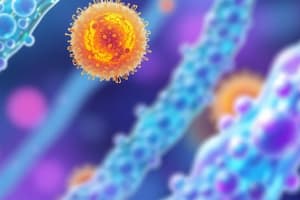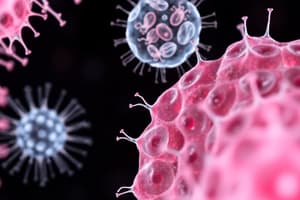Podcast
Questions and Answers
Which of the following is NOT one of the major types of microorganisms studied in Microbiology?
Which of the following is NOT one of the major types of microorganisms studied in Microbiology?
- Viruses
- Lichens (correct)
- Bacteria
- Fungi
Which characteristic is associated exclusively with Eucaryotic cells?
Which characteristic is associated exclusively with Eucaryotic cells?
- Size typically < 5µ
- Binary fission
- No nucleus
- Presence of larger ribosomes (correct)
What type of staining method does the Gram stain represent?
What type of staining method does the Gram stain represent?
- Differential stain (correct)
- Negative stain
- Simple stain
- Fluorescent stain
What is the typical size range of Procaryotic cells?
What is the typical size range of Procaryotic cells?
Which term describes the system where growth rate is controlled by adding nutrients in limiting quantities?
Which term describes the system where growth rate is controlled by adding nutrients in limiting quantities?
How is the dilution rate calculated in a Chemostat?
How is the dilution rate calculated in a Chemostat?
What is the definition of D value in microbiology?
What is the definition of D value in microbiology?
What is one disadvantage of using a hemocytometer to count microbial cells?
What is one disadvantage of using a hemocytometer to count microbial cells?
Which bacterial species corresponds to the dimension approximately 0.5 µm X 10-25µm?
Which bacterial species corresponds to the dimension approximately 0.5 µm X 10-25µm?
What provides rigidity and shape to a bacterial cell?
What provides rigidity and shape to a bacterial cell?
Which statement correctly describes the action of lysozyme on bacteria?
Which statement correctly describes the action of lysozyme on bacteria?
Which structure in bacteria contains Dipicolinic Acid?
Which structure in bacteria contains Dipicolinic Acid?
Which of the following is not classified as a viral disease?
Which of the following is not classified as a viral disease?
What does the abbreviation CFU stand for in microbiology?
What does the abbreviation CFU stand for in microbiology?
What are the categories of nutrition types in microorganisms?
What are the categories of nutrition types in microorganisms?
Which structure is called the viral protein shell?
Which structure is called the viral protein shell?
Flashcards
What provides the rigidity and shape of a bacterial cell?
What provides the rigidity and shape of a bacterial cell?
A rigid structure that gives bacteria its shape and protects it from osmotic pressure.
How does the enzyme lysozyme cause bacterial lysis?
How does the enzyme lysozyme cause bacterial lysis?
Lysozyme breaks down the β-1, 4 linkage between NAM and NAG in peptidoglycan, disrupting the bacterial cell wall structure, leading to lysis.
What bacterial structure contains Dipicolinic Acid?
What bacterial structure contains Dipicolinic Acid?
Dipicolinic acid is a unique chemical found in bacterial endospores that helps them resist harsh conditions.
What is the protein shell of a virus called?
What is the protein shell of a virus called?
Signup and view all the flashcards
What do PFU and CFU represent in microbiology?
What do PFU and CFU represent in microbiology?
Signup and view all the flashcards
What are the characteristics of fungi?
What are the characteristics of fungi?
Signup and view all the flashcards
What are the four categories of nutrient uptake in microorganisms?
What are the four categories of nutrient uptake in microorganisms?
Signup and view all the flashcards
What are the four categories of nutrient uptake in microorganisms?
What are the four categories of nutrient uptake in microorganisms?
Signup and view all the flashcards
What are the 5 major types of microorganisms studied in Microbiology?
What are the 5 major types of microorganisms studied in Microbiology?
Signup and view all the flashcards
What are key differences between Eucaryotic and Procaryotic cells?
What are key differences between Eucaryotic and Procaryotic cells?
Signup and view all the flashcards
What type of staining is used in the Gram stain?
What type of staining is used in the Gram stain?
Signup and view all the flashcards
What is the decimal reduction time (D value) and how is it calculated?
What is the decimal reduction time (D value) and how is it calculated?
Signup and view all the flashcards
What is a chemostat?
What is a chemostat?
Signup and view all the flashcards
What are the advantages and disadvantages of using a hemocytometer for cell counting?
What are the advantages and disadvantages of using a hemocytometer for cell counting?
Signup and view all the flashcards
How is the dilution rate calculated in a Chemostat?
How is the dilution rate calculated in a Chemostat?
Signup and view all the flashcards
What are the typical conditions for heat sterilization in an autoclave?
What are the typical conditions for heat sterilization in an autoclave?
Signup and view all the flashcards
Study Notes
Microorganisms
- Major types studied in Microbiology: Bacteria, Viruses, Fungi, Protozoa/Protists, Microalgae
Eucaryotic vs. Procaryotic Cells
- Eucaryotic Cells:
- Typically larger than 10µm
- Contain a nucleus
- Membrane-bound components/compartmentalization
- Larger ribosomes
- Mitosis/meiosis or budding/sexual reproduction
- Procaryotic Cells:
- Typically smaller than 5µm
- Lack a nucleus
- Lack membrane-bound components
- Smaller ribosomes
- Binary fission/asexual reproduction
Gram Staining
- Type of staining: differential stain
Heat Sterilization
- Typical conditions: 30 minutes at 64°C or 15 minutes at 121°C
Chemostat
- Open system
- Growth rate controlled by nutrient addition at the same rate as medium removal
Dilution Rate Calculation
- Formula: D = F/V, where D is the dilution rate, F is the flow rate and V is the volume
- Steady state achieved after certain volume changes.
Hemocytometer/Counting Chamber
- Advantages: Easy, inexpensive, quick
- Disadvantages: Can't differentiate live from dead cells; needs microscope or staining
Decimal Reduction Time (D value)
- Time required to reduce a population by one log cycle (90% reduction or 10% remaining)
Sigmoid vs. Diauxic Growth Curve
- Sigmoid: One log phase
- Diauxic: Two log phases
Catalase Enzyme Absence
- Usually absent in anaerobic microorganisms
Bacterial Species Matching and Dimensions
- Match bacterial species to provided dimensions
Bacterial Cell Structure and Composition
- Cell shape and rigidity: Provided by peptidoglycan
- Lysozyme activity: Interferes with transpeptidation in peptidoglycan
- Bacterial structure with Dipicolinic Acid: Endospores
Endospore-Forming Bacteria
- Examples: Clostridium, Bacillus (and others mentioned in the lecture but not on the notes)
Virus Protein Shell
- Capsid is the virus protein shell
Bacterial Diseases (not caused by viruses)
- Diphtheria
PFU & CFU
- PFU: Plaque-forming unit
- CFU: Colony-forming unit
Cytopathic Effects of Viral Infection
- Two types (not specified)
Synsytia (multinucleate cells)
- Cell fusion
- Bacterial cell features related to the cell walls in Gram positive and negative bacteria
Inclusion bodies
- Intracellular structures that may contain viral particles or other components
Fungal Characteristics
- Fungi are heterotrophs that decompose organic matter
- Spores can be produced by sexual reproduction
Microbial Nutrition Types
- Photoautotrophs
- Chemoautotrophs
- Photoheterotrophs
- Chemoheterotrophs
Microbial Nutrient Uptake
- Simple/passive diffusion
- Active transport
- Facilitated diffusion
- Group translocation
Lysogeny
- Viral genome is integrated into the host chromosome, does not result in lysis of the host cell
Prion diseases
- Causative agents for mad cow disease and other similar neurological diseases
Endospores
- Produced in certain genera (Bacillus and Clostridium)
Studying That Suits You
Use AI to generate personalized quizzes and flashcards to suit your learning preferences.





